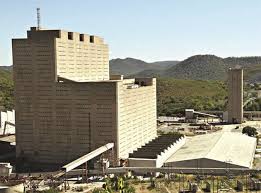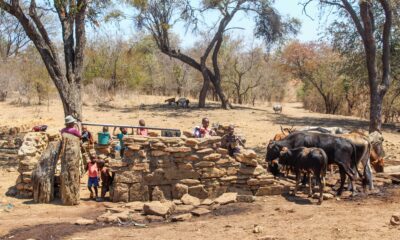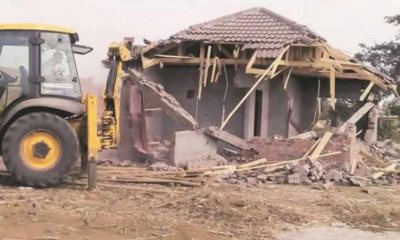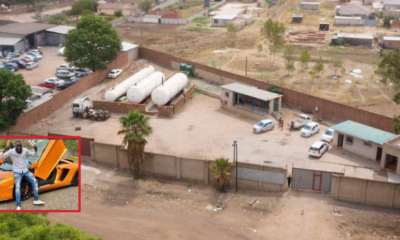
Business
Implications of closed mines on economy
Published
4 years agoon
By
NewsHawksZIMBABWE has a large number of large-scale mines that have shut down, a development which has become a major stumbling block as the country seeks to build a US$12 billion mining sector and position it at the centre of an ambitious economic revival blueprint, a new report has revealed.
DUMISANI NYONI
In its latest report titled State of Closed Large- and Small-Scale Mines and their Relationship with Artisanal Mining, the Zimbabwe Environmental Law Association (Zela) said the mines closed due to government interference, mismanagement, poor economic and political environment.
The report, conducted between August and November 2020, says some of the closed mines are Nan Jiang Africa, Mashava Mines, Athens Mine, Ran Mine, Alaska Mine, Mazowe Mine, Madziva Mine, Giant Mine, Shabanie Mine.
Nan Jiang Africa
In Bikita, close to the Save Valley Conservancy, there is an abandoned diamond mine, Nan Jiang Africa. The mine was set up at the height of the Marange diamond fiasco. A consortium of Chinese and Zimbabwean firms registered Nan Jiang Africa Resources Ltd.
However, the mine was closed prematurely due to a dispute with the Ministry of Mines and Mining Development following reports that the mine had set up offices and processing facilities before submitting the application for a mining licence. The company had built structures for more than 100 workers from Bikita and Buhera.
In March 2013, it was reported that diamonds were discovered in four kimberlitic pipes at Devuli Ranch in Bikita by this consortium. Since the consortium only had a prospecting licence, upon its expiration they left without any recorded production, reporting that there were no diamonds on site.
“This misrepresentation of information calls for government action to invest in exploration to increase information in the ministry’s geological database. The mine has never operated since it was set in 2014,” report reads.
“The Nan Jiang fiasco demonstrates how companies lost money in the diamond rush in areas around Marange. A massive loss in capital was discernible—the mine invested in mining equipment, a processing plant and diamond sorting facilities. Socially, the community expressed concern over the company’s failure to adequately consult them and to give them information on the nature of their operations and reasons for termination of operations.”
Presently, Zela said even the security guards who used to protect the big mining complex which houses the mine offices and diamond sorting room appear to have abandoned the site.
“Villagers in the area reported that the company had told them that they have not been getting enough quantities of diamonds for them to continue mining. For the villagers, the potential for diamond mining in the area had brought hope for employment of youths in the drought-prone Budzi area in Bikita,” it said.
Mashava Mines
Zela also visited Mashava Mines, located 40 kilometres from Masvingo town. Asbestos was mined in the area. Mashava had different mines dotted around the area, including Bosmine and Lenox Mine, which used to mine asbestos, but are now mining gold, which is being done by artisanal miners.
Diso Mine in the area used to extract asbestos. All these asbestos mining companies are closed. There were three mines in Mashava, including Gaths Mine, King Mine and Temeraine Mine which were allegedly owned by Mutumwa Mawere under the banner of Shabanie Mashava Mines (SMM) through Africa Resources Limited (ARL) before they were taken over by the government.
“Mawere was specified by the government on allegations of externalising $30 billion in foreign currency. Government passed the Presidential Powers (Temporary Measures) (Reconstruction of State-Indebted Insolvent Companies) Regulations of 2004 to take over SMM under the pretence of preventing it from collapsing and saving jobs,” the report reads.
“Some former workers argue that the takeover of the mines from Mawere by government was not proper, while others state that while government had failed dismally to run the mine, Mawere had duped them and did not pay them their dues as he was stashing money and asbestos fibre in South Africa.”
The report says interviews with current and former workers at King Mine indicated that in 2004 government officials held a rally at Gaths Mine Stadium where they declared that they had taken over the mines.
The following were notable government officials who rallied the workers and villagers at the stadium: Emmerson Mnangagwa (current President), Patrick Chinamasa (former minister of Justice), Jonathan Moyo (minister of information) and others.
“Slowly the mines started to deteriorate—spare parts were not being replaced, vehicles breaking down and not being repaired, water levels rising, low worker morale, salaries not paid, and electricity bills started accumulating,” the report reads.
Some workers are owed in excess of US$40 000, it said.
“Now, only 600 workers remain on unpaid leave and 10 workers are responsible for de-watering the mine. They are being paid RTGS1 500. King Mine used to employ around 5 000 workers at its peak,” the report says.
“King Mine is only open for pumping water out of the mine so that it does not flood. However, sometimes this is affected by electricity outages due to non-payment.”
Zela said it was reported that the state-run Zimbabwe Mining Development Corporation (ZMDC) tried to take over King Mine to extract chrome, but was not successful. Many former workers opine that the government took something it could not manage.
In 2019, there were reports that King Mine would resume production in 2020 when the de-watering process and repairs on the mill were done. However, as it stands, the mine is still in a derelict state. Mountains of asbestos mine waste and dump can be observed around Mashava.
Zela witnessed the sad reality of poverty, economic decay and loss of former glory in old mining towns.
An interview with one of the former employees revealed that some ex-employees and dependents of late workers were evicted from the company houses at King Mine.
Zela said there is an upsurge in artisanal chrome and gold mining activities around the Mashava Mines.
Most of the workers on retirement, those retrenched, on forced leave or currently at work now depend on artisanal chrome mining in the King Mine concessions.
Those who are still at work at King Mine, for example, conduct artisanal chrome mining during their off days, at weekends or after work. Some managers at King Mine are also reported to be running chrome-mining syndicates or groups while others have ventured into artisanal gold mining.
The artisanal miners sell chrome for US$1 per wheelbarrow to the Chinese.
In an interview, a chrome buyer at King Mine who buys from artisanal miners indicated that he buys a tonne for US$10 to sell to Chinese smelters in Gweru who, in turn, buy at US$35-US$40 per tonne.
There is a lot of chrome in the area. At some point a company called GD was granted permission to mine chrome near King Mine, but has since stopped, Zela said.
“However, the situation is distressing for many families and former workers. Houses have been abandoned while most of the infrastructure at the mine is collapsing,” it noted. Zela said the machinery at King Mine and Temeraine is highly depreciated and outdated. Gaths Mine was sold to Great Zimbabwe University and is now being run as a university in the midst of mountains of mine waste.
Athens Mine
Athens Mine is located in Mvuma in the Midlands Province. The gold mine was closed and is under care and maintenance. The ownership of the mining claim was passed from Falcon Gold, to Lonrho, and to Duration Gold since the time of closure.
Mvuma is now a pale shadow of its former hustle and bustle and high status. Gold mining began in 1910 and production ceased in January 1998 due to unstable ground conditions which caused a major accident.
When the mine was operating at full capacity, job seekers came from across the country and neighbouring countries of Mozambique, Malawi and Zambia seeking employment at Athens Mine which, according to records, in 1914 employed 110 Europeans and 1 500 Africans.
A mine shaft collapse affected production and the low price of gold, resulting in the halting of operations in 1998. Residents attest that when Athens Mine was closed it was taken over by a local company, Duration Gold—headquartered in Bulawayo—working the gold ore dumps.
Closure of the mine left the mining community of Mvuma poverty stricken. Historically, more than 75 000 people living in the central region district of Chirumanzu depended on the now-dilapidated town.
“Unemployment is high as the town does not have other sustainable forms of industrial activities employing many people. The local communities are surviving on gold panning and small-scale chrome mining,” the report says. On a positive note, Zela said Duration Gold instituted a mining scheme for artisanal and small-scale miners to work on its gold claims as cooperatives.
Interviews with artisanal miners indicated that Duration Gold introduced a new programme to promote formal mining by artisanal miners. The mine entered into agreements with the artisanal miners to work on the old mine pits and dumps at Athens Mine. It was reported that more than 30 miners are working as cooperatives of artisanal miners in the area.
Ran Mine
Ran Mine is a gold mine located in Bindura. It has been in the news of late, after more than 10 miners were trapped in a disused mine shaft.
The mine was exploited by GNP Industries, a German company, for 103 years and closed in 1999. After the closure, Exdrill Mining continued with the mining operation and employed 20 workers who then lost their jobs after the company ceased operations.
The workers who were working under the former company, despite being given assurances that they would be employed by the successor company, lost their jobs.
Currently, Aurora Gold began exploiting the mining claims through a sub-contract and thereafter issued eviction notices to the Exdrill workers. Aurora’s workers stay a few metres away from the mining facility and that is where their homes, called “camps”, have been constructed.
“The company is not providing residents with water. On remuneration conflicts, one interviewee noted that she was earning less than US$15 as a formal employee to Aurora, but after joining the ASM (artisanal small-scale mining) sector she is realising USD80 per week,” it said.
More than 1 000 artisanal and small-scale miners are operating at Ran Mine, the interviewee estimated.
On housing conflicts with miners, there are reports that no due diligence procedures were undertaken in the blasting procedure as noted from some houses that have developed cracks.
“Of interest is that, during the blasting process one house collapsed and one casualty was recorded. Some families were said to be literally mining in their homesteads because the area is generally mineral rich.”
Mazowe Mine
The Mazowe gold field and claims belong to Metallon Gold, which was formerly owned by South African mining entrepreneur Mzi Khumalo. Mazowe Mine is one of the oldest underground mining operations in Zimbabwe.
The mine has a total of 247 claims in 2 939 hectares of landholding. The mine was closed in September 2018 due to massive operational challenges. The mine had been placed under administration for a reconstruction order together with another of Metallon Gold’s operations, Shamva Mine. The mine is currently on care-and-maintenance.
Following closure and stoppage of mining, Jumbo Mine, owned by Metallon Gold, has been a theatre of illegal gold mining, violence and criminality. Some artisanal miners would come from Kwekwe and Shurugwi to control gold and underground shafts at mine in Mazowe and this resulted in deadly conflicts.
Some police officials reportedly led the way in manipulating and controlling the syndicates at the mine.
Zela said there are a lot of mining activities in the locality, anyone can mine anywhere, with no questions asked and incidents of farmer-miner conflict have been recorded in the area.
Most of the gold produced by the illegal miners is sold on the parallel market.
Since 2014, the workers were receiving their salaries in erratic instalments. The company, which had more 1 000 workers, has been left with skeletal staff of about 150 people.
Madziva Mine
Madziva Mine is a nickel operation in Shamva that closed in 2001 and was owned by Bindura Nickel Corporation (BNC). The mine commenced mining in 1966. BNC owned Madziva Mine and Trojan Mine, which both closed around the same time. BNC argues that the closure was due to declining nickel prices and unstable ground conditions.
However, some locals argue that it closed for political reasons following the land reform programme. The former mining area is located near the Umfurudzi game park. The Madziva mining site now houses Madziva Teachers’ College.
“The mine owners left most of the mining equipment and the former mine workers argue that anyone can buy the equipment,” the report notes.
Closure of Madziva Mine left many workers stranded without any source of income, forcing many to venture into illegal artisanal gold mining activities in the protected area of Umfurudzi National Park. The gold produced by the artisanal miners is sold on the parallel market.
Giant Mine
Giant Mine is another closed gold mine located in Chegutu district. However, Pickstone has taken over the mine and has conducted exploration at Giant Mine, which it acquired in 2014.
Currently, there are no mining operations going on at Giant Mine, except mine development (shaft sinking) and several assay values being collected to ascertain the profitability of the mine.
The mine belongs to Black Ridge group under Dallagio Investment. In 2017, Danangwe District Mining Youth Cooperative (DDMYC) operated the mine. The contract with DDMYC ended in 2019 after a court resolution following the violation of the tributary agreement with Pickstone Mine. There are no other operations at the mine.
Shabanie Mine
Shabanie was an asbestos mine located in Zvishavane, Midlands province. It used to be one of the biggest private sector employers in the Midlands with more than 2 000 workers. The mine was closed in 2004 due to low demand for white asbestos.
In 2008, the mine was taken over by the government. The mine, under administration, is currently producing 260 tonnes per month of asbestos fibre through a dump re-processing system.
Alaska Mine
Alaska Mine is a large open pit copper mine which is 20km from Chinhoyi town. In pre-colonial times, miners were believed to have mined about a million tonnes of ore at the mine and it was regarded as the largest of ancient workings in Zimbabwe.
It was the centre of smelting and refining operations for all the Lomagundi copper mines. The first smelting was undertaken in 1956. The company used to employ more than 1 500 miners, although now there are only security personnel on site.
“The discussions we had with local people indicated that there are plans for resuscitation and technological upgrades to bring in the mining giant into the 2030 mining vision, although these plans may be affected by the unstable macro-economic and political environment obtaining in the country,” Zela said.
Alaska mine is under the management of Zimbabwe Mining Development Corporation (ZMDC) and was closed 20 years ago due to the poor economic and political environment in the country, leaving more than 1 500 workers unemployed.
“The infrastructure at the mine is rotting and phased out. Most of the equipment is being stolen by people. However, many artisanal miners are mining in the area and these are mining copper from the mine dumps,” it said.
Way forward
Zela said the government should consider conducting a comprehensive assessment and audit of closed mines around the country and share the findings publicly.
The government should also consider, through a public tender system, all closed mines under the control of ZMDC and other state entities to attract responsible investors whose security of tenure should be guaranteed.
“There is a need for the country to come up with a framework that facilitates co-existence between the large-scale mines and artisanal and small-scale miners. In this case the model of tribute agreements which is already included in the Mines and Minerals Act should be implemented as a way of formalising artisanal mining,” it said.
Zela said the government should finalise the minerals policy with the objective of promoting responsible investments in the sector. An audit or assessment of the situation at closed mines should recommend measures or programmes that can be adopted for helping former mine workers and families. These may include granting them mining rights or other social programmes, it said.
“Formalisation of artisanal mining should be considered a priority by the government through passage of mining legislation that creates a permit system for artisanal miners or simply through the approving of tribute agreements that include mining companies or licenced small-scale miners with artisanal miners.”
“The government or other stakeholders can institute a contract monitoring project in the ASM sector to understand the existing contractual arrangements, their effectiveness and weaknesses,” Zela said.
The ministry of Mines and Mining Development should re-introduce regular mine inspection to monitor contract performance while large-scale miners must transfer safety skills to artisanal and small-scale miners, it opined.
The mining industry has potential to resuscitate the Zimbabwean economy if the fluid and never-ending macro-economic, political, human rights and property rights factors and problems are comprehensively addressed by the government.
You may like




















